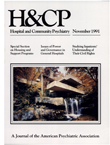Creating a Supportive Environment Using Staff Psychoeducation in a Supervised Residence
Abstract
The prevailing approach to rehabilitation in residential care emphasizes goal attainment. This approach often produces considerable stress for residents, most of whom have schizophrenia. Based on the view that low-demand environments, incorporating graduated expectations, may be more appropriate for this patient population, a three-component model for creating and maintaining a calm, supportive environment in a supervised residence was developed. The model utilizes staff psychoeducation, which is based on the principles of family psychoeducation, a highly effective intervention for patients with schizophrenia. The three components of the model are training in supportive interaction, a medication-monitoring program, and a behavioral approach to problem solving. Resident groups promote each of these components. The groups' goals are encouragement of positive, low-key interactions, compliance with medications, and slow, steady rehabilitation.
Access content
To read the fulltext, please use one of the options below to sign in or purchase access.- Personal login
- Institutional Login
- Sign in via OpenAthens
- Register for access
-
Please login/register if you wish to pair your device and check access availability.
Not a subscriber?
PsychiatryOnline subscription options offer access to the DSM-5 library, books, journals, CME, and patient resources. This all-in-one virtual library provides psychiatrists and mental health professionals with key resources for diagnosis, treatment, research, and professional development.
Need more help? PsychiatryOnline Customer Service may be reached by emailing [email protected] or by calling 800-368-5777 (in the U.S.) or 703-907-7322 (outside the U.S.).



